Wither conformation - seeing the damage
Posted by RodandDenise on April 24, 2015
We are no longer building saddle trees, but we have two videos about how Western saddles fit horses available on our westernsaddlefit.com website.
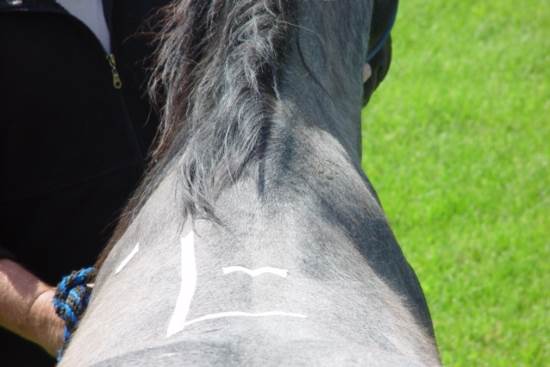
By contemplating equine back conformation (not a normal activity for normal people, but definitely normal for tree makers) you come to realize there is quite the range of variation of normal, and I wrote about that recently. However, on even further contemplation we have come to recognize the abnormal. It has taken a while to “see” it, since we actually see it so often. But common does not mean normal and we now recognize that a lot of what we have been seeing for years actually isn't “normal”.
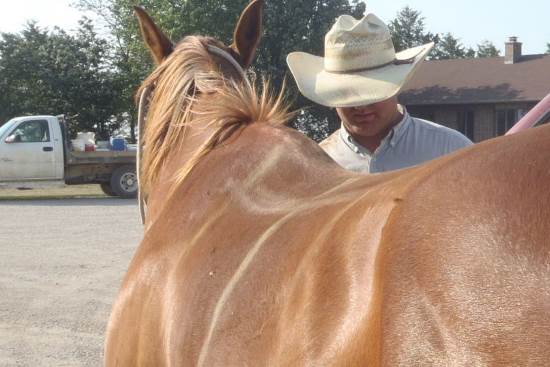
In our blog post about normal wither conformation, I kept stressing that the transition between the shoulder blade and the wither pocket area is smooth, even on horses who naturally have quite a concave wither pocket. The muscle in the wither pocket on this horse is normal and there is a very smooth flow over the shoulder blades. (The chalk line is at the back of the shoulder blades.)
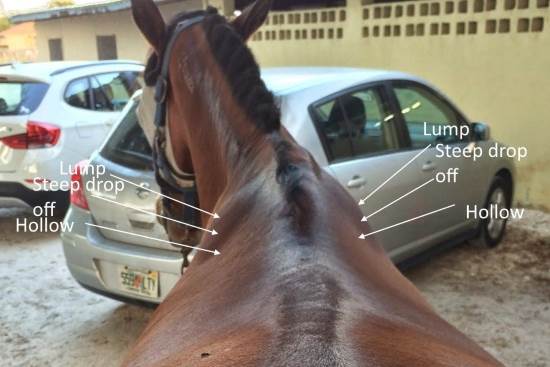
Contrast that picture with this one. This horse is damaged. His wither pocket area is sunken compared to what it was prior to a specific saddle being used on him for a couple of years. He also is showing the “lump and hollow” we now recognize as a result of excess pressure over the back of the shoulder blade caused when the muscle is compressed between the bone and the bar of the saddle tree. (Note that this doesn’t happen with well designed saddles that are properly positioned.) Scar tissue builds up from chronic damage, creating a firm lump. Behind the lump, the muscle is atrophied. And between the two is a pretty steep transition zone.
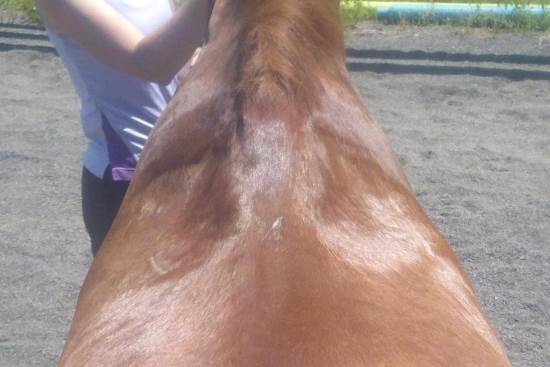
Muscle atrophy occurs when excess pressure causes the muscle to waste away. (The physiological and biochemical causes of pressure damage are still debated by the academics, but there are likely a lot of factors that contribute to it.) Here is an obvious case of atrophy where you can see the hollowing of the wither area. The way the sun is shining on the coat, you can even see the edges between normal and atrophied muscle.
The worse examples of atrophy I have seen to date have come from horses ridden primarily in English saddles. At a seminar on saddle trees which we were presenting a few years ago we had a saddler from the eastern US attending. In discussing atrophy, I put up pictures of what I considered to be severe atrophy. Their response was “We see that every single day.” This is a picture she sent me later of a horse she was dealing with. While it is severe atrophy, she says this is really common in the horses she sees. Not normal. Common. There is a difference there…
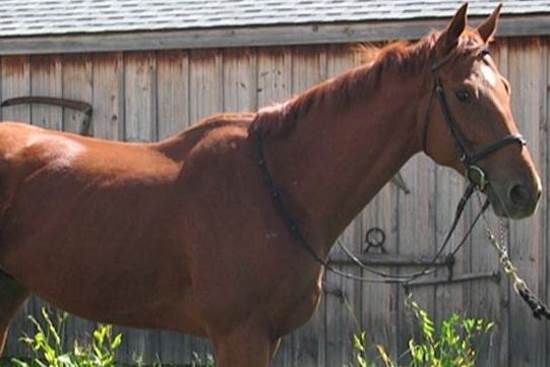
Here is another picture I snaffled off the net. If you look in horse forums, you can find all sorts of pictures of horses that look like this. I have this labelled as being a six year old TB ex race horse, primarily ridden English. You can see how pronounced the back of the shoulder blade is and the amazing atrophy behind it. (In fact, on a lot of horses ridden in poorly fitting English saddles, you can see the atrophy extending back under the entire length of the saddle.)
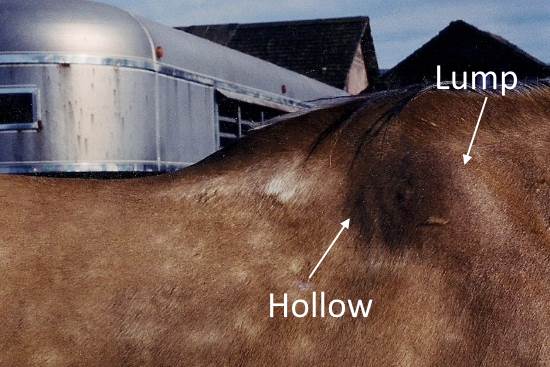
But it isn’t just atrophy we are seeing in our western horses. There is also a lump at the back of the shoulder blade. This is a picture we took a few years ago of a well used ranch horse. He was a narrower built horse for sure, but instead of a smooth transition between the concave wither pocket and the shoulder blade, he has an obvious lump. The area covering the back of his shoulder blade rises up in a discrete lump and then drops off suddenly into the hollowed out wither pocket behind the shoulder blade.
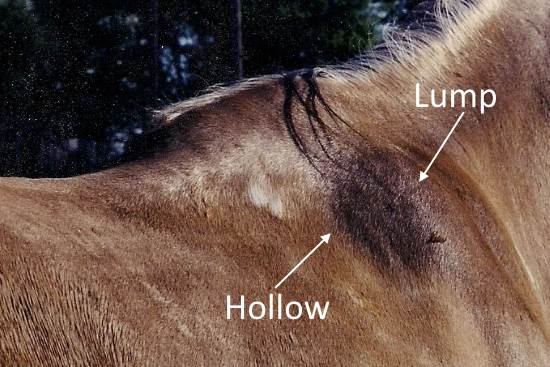
Here’s another picture of the same horse from a different angle. It is harder to see the front edge of the lump from this angle, but easier to see the steep transition at the back of it.
Note: this lump is often present in horses ridden English as well, but while I have seen English horses without much of a lump and a fair bit of atrophy, I haven’t yet recognized a horse ridden primarily in a western saddle with atrophy behind the shoulder blades but without the lump. Note the "yet" in that sentence...
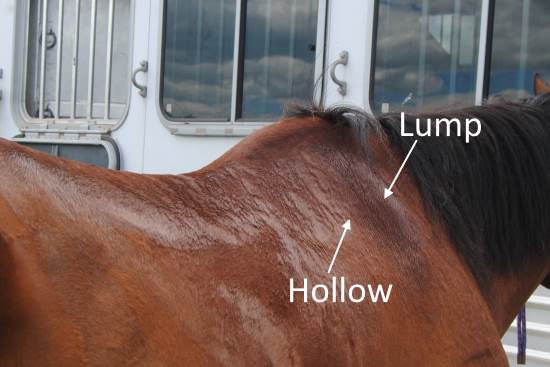
Here’s another example in a horse ridden both western and English. I would suggest this horse has atrophy down the length of his back as well, but what I want to point out is the distinct lump over the back of the shoulder blade. That lump isn’t there on all the pictures of normal withers I put up in the earlier post. But it is there on damaged horses. In talking with some people who do body work on horses (massage, etc.) they recognize this abnormality, though it isn’t discussed in the veterinary community yet as far as I can tell. Again, is it just so common it is seen as “normal”? I don’t know. But now that we recognize it, we see it everywhere.
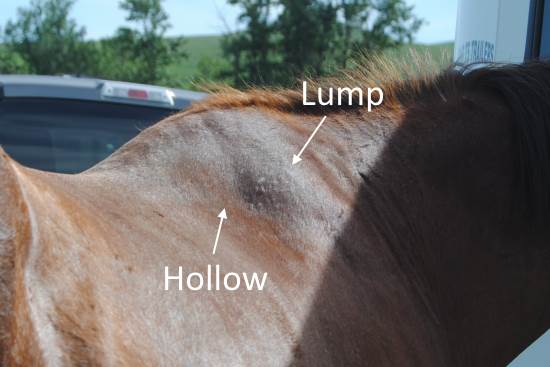
See what I mean? This is another old ranch horse – solid, used for roping for years, but showing the lump and hollow effect of saddle pressure over the back of his shoulder blades. This side shows the issue, but it isn’t dramatic.
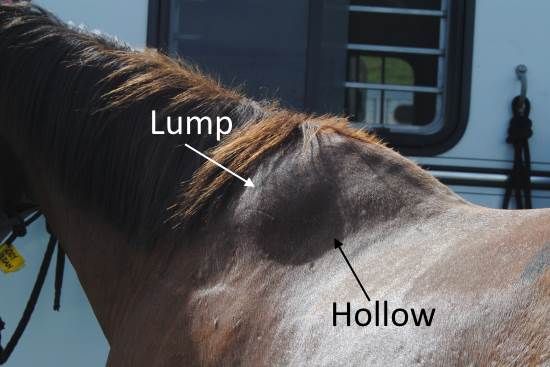
Same horse, other side, more severe problem. It is common that one side has a larger lump than the other. In fact, if you look at the grey horse at the top of this post, while you can see he has the lump and hollow, it is worse on his right than his left. The third picture of the bay horse shows the left side worse than the right. Asymmetry in horses is very common, so it is not surprising that the damage isn’t equal side to side either.
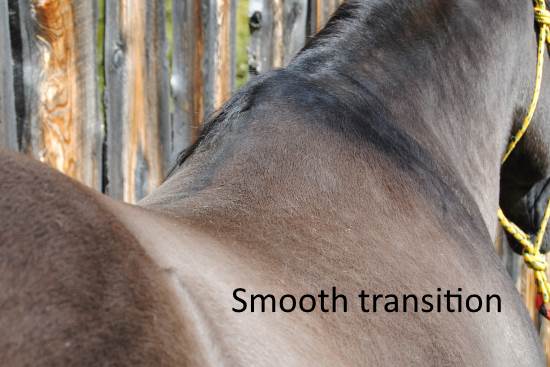
And, just to show that it isn’t just age that does this, here is Gus. He was somewhere between 20 and 25 when this picture was taken. He had been used for a lot of years as a ranch horse and he had had some arena roping done on him as well. But there’s no lump, no hollow. Horses don’t have to be damaged by saddles.
Now think about trying to fit a saddle on these horses. Which is easier – the normal horse with the smooth transition or the damaged lump and hollow horses? The answer is obvious. Can a severe lump and hollow horse even be fitted really, really well? That answer is pretty obscure. We don’t know. So the best “cure” is prevention, by properly positioning your saddle. Make sure the front bar tip is behind the shoulder blade so the muscle isn’t compressed between bone and bar and isn’t damaged. (And unless you are doing something that is actually pulling or pushing the saddle back, like dragging calves, take off the breast collar! Let the saddle go where it wants! You may be surprised where it really fits, and your horse will be happier. There. Said it. Out loud. And in public…) There’s lots more to write on this topic, but this will do for now.
COMMENTS:
Posted by FAVRAT on Apr 25th, 2015
Hi, I'm a french reader of your blog, and I'm very interested in saddle fitting.
My english is very bad, so I hope you will understand what I want to say.
First, I woul'd like to thank you for time you spent to teach and share, with humor and a lot's of pedagogy. It is very nice to read.
Thank you so much, really!
My young mare have a kind of lumb on the top of the shoulder blade... The wither pocket isn't flat, muscles doesn't looks like atrophied.
I choose a saddle with a lot of flare, and the sweating marks are quite good, BUT, because of she is downward conformed, the saddle tend to go forward as soon as there is a slope or in the downward transitions -> shoulder blade compression!
Her withers have a sort of U (an upside down U, exactly) shape: space between tops of the shoulder blades is very wide, but the angle of the shoulders is very narrow. It looks like some Arabian, but wider.
Can we confond a U shape with dammages due to a poor fitting?
If dammage there is, are they reversible (with working on line first, and an appropriate fitting and saddle placement then) or not?
Have you got some experiment about this?
I wish you a good week end, and thank you so much (again!)
Posted by Leslie Ball on Apr 25th, 2015
This is an excellent article; I will be having a look at my horses.
Can this hollow / lump be corrected? How would you go about fixing this?
Thank you.
Posted by Nat Murphy on Apr 25th, 2015
I have sent a separate email with photos of my horse... English ridden and 9yr old... would love to hear your thoughts... the 'lump' is hard to photograph but the triangle i think you will be interested in ...
Posted by Jesse on Apr 25th, 2015
Very informative!
I am interested in further information about fixing the wither poker and lump. And proper position and fur for English saddles; as there seems to be a lot of controversy.
I have a few rescued tbs here with very obvious wither pockets and one with a very large shoulder lump.
I am using "fitted" saddles for their conformation and padding up their wither pockets. With the intent of muscling them up for a smooth back. Is this a correct approach?
Thank you!
Posted by RodandDenise on Apr 25th, 2015
E-mail responses to each commenter are coming. As to if/how this can be fixed, that is rather out of our area. I know that muscle atrophy can be reversed if it is not too serious, but once the muscle cells are gone and all that is left is scar tissue, it can't be fixed. So that depends on the length and severity of the damage. As far as the lump - again depends on what it is made of now. If it is long term scar tissue, I doubt it can be removed. If it is shorter term and primarily swelling and inflammatory responses, then I think it could be. The problem is preventing further damage, and getting a saddle to fit behind a cliff like transition zone and still let the shoulder blade move back from that cliff - well, that might be asking the impossible. Lots of questions, not a lot of answers, unfortunately.
Posted by Don Doran on Apr 25th, 2015
The thinner thoracic trapezius and latissimus muscles lay over the superficial caudal dorsal (back of, upper portion) aspect of the scapula. Consistent irritation through incorrect tree width, saddles set to far forward (as you noted with English saddles), and too straight western bars, will eventually create a build up of scar tissue creating a "lump" over the scapula in conjunction with the atrophy. In addition the biomechanics of the horse will be compromised thru excessive abduction (wide) movement of the shoulder and leg to relive the "pinching effect" at the scapula resulting in excessive use and build up of the subscapular muscle (buildup under the scapula) adding to the "lump" profile. The problem usually results in a torque pattern (this is why often only one side) in the horse's front end to relive the pressure eventually creating a torque in the spine affecting the lumbar/sacral articulation and a painful lower back condition. Just my 2 cents and IMHO. Of course for the western rider, riding with a Nikkel's tree will avoid this mess!
Posted by Don Doran on Apr 25th, 2015
Muscular rehabilitation of the area as you noted is dependent on degree and time length of the problem. A mistake often made is to "fill in the atrophied area" with English wool flocked saddles, or spot riser pads. Both actually will continue to maintain and increase pressure on the muscle reducing blood flow to the atrophied muscles that you are wishing to build up. Utilizing a 3/4 wool felt (+/-) pad throughout the back will assist in lifting the front of the saddle while allowing circulation through proper rehabilitative exercise to help restore muscular integrity to the degree obtainable in the individual. The "lump" (scar tissue & overdeveloped subscapular muscle) though is usually a permanent condition often resulting in horsemen mistakenly attempting to "work" the opposing side to get it to match the muscularly deformed side! In some of these permanent cases a thickness of "graduated padding" difference from side to side can be of assistance as long as the tree properly fits. You guys do wonderful work!
Posted by RodandDenise on Apr 25th, 2015
Thanks for your information, Don! I was going to e-mail you and ask if you could help us out with some of these questions, and you beat me to it. So people know where this information is coming from, Don Doran is very experienced with equine sports medicine, both practicing and teaching. He started with human massage back around 1990 and transferred that knowledge to horses. He had lots of horse experience prior to that with some pretty competitive equines - to put it mildly. So I trust his knowledge when it comes to rehabbing horses and keeping them in good shape as they work. His webpage is http://equinesportsmassage.com/
Posted by Christina Savitsky on Apr 25th, 2015
I recently watched a LONG saddle fit video on caldwellsaddle.com where Charon said that fitting the saddle over the shoulder was the only way to keep the front bars of the tree from digging in behind the shoulder. Listening to it, it made a lot of sense to me, since I like how a wade fits a horse better than a swell fork since it allows the rider to sit a bit more forward with less tree/weight/etc. up front. Now we don't want it restricting shoulder movement either!
Thanks for posting, keep the info coming!!
Posted by RodandDenise on Apr 25th, 2015
Christina, we disagree 100% with the theory that you want to put weight on the shoulder blades. In fact, we believe that is what causes this issue - muscle over the shoulder blade being compressed between the bone and the bar causing muscle damage, scar tissue build up over the shoulder blade and atrophy of the muscle behind the shoulder blade due to the damage done to it. A well designed bar tip doesn't dig in behind the shoulders. It matches the shape of the horse so it curves away from the shoulder blade along the smooth transition of a normal horse. Well blocked skirts conform to that shape and carry it forward, further making a curve for the shoulder blade to slip under at full extension. With no weight on the leg, there is no pressure to compress muscle between bone and bar because the shoulder blade is not attached with bone but only soft tissue. When there is weight on the leg again, the shoulder blade is out front of the bar, so the muscle isn't squished. If you have the bar on the shoulder blade, you will damage the muscle. The pressure there is just too high.
And yes, you may get away with a shorter seat on a slick fork saddle so you might sit a bit further forward because your legs may go over the fork a bit more - so long as you don't have bucking rolls on it. But most people will use the same room in the saddle in a swell fork as a slick fork. Some people have the idea that there is something magical about the fit of a Wade versus other styles of forks. Nope. Any style of fork can go on any type of fit for a horse - if the tree maker is willing to build it. Sometimes finding those combinations in production trees is difficult though.
Posted by Ady McIntosh on Apr 26th, 2015
Very interesting to read your theory - which makes sense of course. I have 2 endurance horses started at different times but both have developed this problem with a lot of time spent in english saddles.The first one was diagnosed with low heel high heel syndrome thus being one shoulder sitting higher than the other because of heel heights being different. Didn't think any more of it when 2nd one looks the same with uneven front feet in relation to heel height. Your thoughts????
Posted by RodandDenise on Apr 26th, 2015
Ady, How a horse's feet are affects how he moves his legs, including his shoulder blades, and that relates to the saddle. How a horse's saddle fits also relates to how he is willing to move his legs (see Don's information above) and that affects how his hooves wear if he is not shod, and how the weight is placed on his feet whether he is shod or not. So yes, it makes sense that the two things - how the saddle damage occurs and how his feet are - are related. Now, which comes first is a chicken and egg question. But I believe you can have hoof issues without saddle damage if you have good fitting saddles. (And in the same way you can have saddle damage without feet issues...)
Posted by bree on Apr 26th, 2015
I want to buy a saddle for my horse. He has never had a proper fitting saddle because his previous owner was cheap and borrowed everyone else's saddle . I'm really confused as to how I can figure out if a new one fits him. I don't have a ton of $ for custom fit, so what would be next?
Posted by RodandDenise on Apr 26th, 2015
Bree, To start with, take a good look at your horse's back and try to determine if it has issues you will need to concerned about causing problems - very wide or narrow, extra rock, super high withers, etc. There is a three part blog series on evaluating a horse's back for fit starting here: http://www.rodnikkel.com/content/saddle-tree-blog-from-shop-and-desk/evaluating-horses-back-saddle-fit-part-one/ Then you start to look for a saddle for your style of use keeping in mind any special factors - ie. need short bars. Remember that there are no standard measurements in the saddle industry so you can't go by that totally, though it gives you a place to start. (http://www.rodnikkel.com/content/saddle-tree-blog-from-shop-and-desk/what-do-quarter-horse-semi-quarter-horse-and-full-quarter-horse-/) If you have the option of taking your horse to a tack store to try on saddles to see how they fit, that is ideal. Put them up on the horse a bit forward of where they should be (bar tip just back of the shoulder blade) and shake them side to side to let them settle where they should. If they don't settle somewhere quite solidly, they don't fit. You also need to sit in them to make sure they fit you and seat you properly in the saddle. If it fits the horse and you fight it all the time because it doesn't fit you, then it will bother your horse too as you constantly shift around in the saddle. Then when you find one that fits you and the horse, you have to ride it to know for sure if it works. It should be solid on the horse, not moving around. The horse should be moving freely and comfortably. Ultimately, the proof is in the pudding - how does it ride.
Posted by Stacy on Apr 27th, 2015
This has been the most informing information I have found about this issue. My mare has developed this problem and based on what you have said I do believe it has come about from putting my saddle on too far forward. Now that I have this problem, my poor mare is sore... So sore that when she is lounged with no tack she moves clean and fine, if I put a saddle on her she can barely move and acts like she is going to drop on her front end from the discomfort. I have given her a lot of time off and wondered once there is this problem, what are your suggestions to help fix it or make her more comfortable. Thank you again for your insight. Truly amazing and thoughtful information you shared.
Posted by DOn Doran on Apr 28th, 2015
As described in my previous post often scapula distortion leads to torqueing of the spinal column resulting in severe pain at the lumbar/sacral articulation (lower back). This will create a deeper problem in the sacroiliac ligaments, the deep ligaments which attach the sacrum to the pelvis. Those horses affected will have constant deep discomfort in the area and will seek a posture which best alleviates the discomfort. By the way, this uneven weight distribution also is true in the similar human sacroiliac condition. In the quadruped’s case often weight will be unevenly distributed to the front feet with this stance favoring one foot over the other. The constant pressure in standing with this uneven weight distribution will lead to compressed heels and or underslung foot/heels over a period of time. One evaluation is to see if the horse has a hard time squaring up and holding that position, inability to do so may point to the described condition. Problems straight line backing can also point to sacroiliac problem. The permanence in this condition is often addressed by utilizing wedges with the lower front foot to even the medial radial condyles (the inner boney prominences at the top portion of the knee).
Posted by RodandDenise on Apr 28th, 2015
Ady, Above is Don's response to the low heel, high heel problem. Stacy, Don said he would chime in on your question tomorrow.
Posted by Ady McIntosh on Apr 28th, 2015
Thanks Don for your input and adding to my can of worms!! The sacro iliac idea could well be active in both. The older (24) retired horse has always rested one hind with the opposite foreleg placed forward.When in a soft sand yard he stands slightly stretched out with back toes tilted downward into the sand.This horse has always been sound and done over 5,000km of endurance! But have always wondered where his discomfort may be when resting. The other younger current competition horse rests a hind but crosses it in front of the one he is standing on! I shall run your tests and see how he handles that.He does not like going straight downhill as has difficulty keeping back end gathered underneath,moreso than any other I have ridden. Cheers,this is very interesting!
Posted by Don Doran on Apr 29th, 2015
Location of the primary pain is essential for correct assessment of an individual. The next step if the pain is acute is to get the individual out of pain so the healing process can begin. From Stacy’s description of movement in and out of the saddle, and described discomfort when under tack the problem may point to a neuropathy (nerve) compression in the upper thoracic area of the spine. Often horses presenting this problem have muscular back weakness and the addition of weight causes them to drop the back thus compressing the vertebrae, creating discomfort. If the problem was due to full fusion of the vertebrae and neuropathy the discomfort would be continual and not just under weight or tack.
Strengthening the muscles of the back is the first order in a rehab situation like this once pain is under control. Turnout alone will not alleviate the problem and in most cases will create weakness of the muscles thru nonuse. A recommendation is non rider/weight bearing exercise. This is generally not what the majority of riders what to hear as riders like to ….ride!
I prefer straight line jogging behind a golf cart or ATV with graduated weight addition to a properly fitted saddle over a period of time. Jogging weight addition can be added up to 50 -60 pounds. I work the first 2-3 weeks, 5-6 days a week, with no saddle or weight, another 2 weeks with saddle then begin to add weight in 10 lbs. increments weekly. This exercise will strengthen the back muscles for preparation of a rider in a properly fitting saddle. I do not recommend lunging as this does not work with the proprioception of the muscles of the back, nor do I care for treadmills. There are a number of other exercises but straight line jogging is my first preference in addition to the others.
Time frame of the rehab is another factor as human thought process often thinks of a few days for recovery. As a professional I tend to measure rehab in 6 week increments with 12 to 18 weeks being a goal depending on the severity of the problem. Keep a log as to your program and let your horse be your guide.
Posted by Aryana on Jul 2nd, 2015
Thank you all for sharing, so much time and effirt of your own, with those of us looking for answers.
Posted by Kristi on Jul 18th, 2015
I am curious as I ride dressage and actually do not feel good using a standard *english* (forward seat) saddle. I had a mare try to lay and roll with me on a western saddle and it was 3/4s, she was wide withered but good shouldered. Needless to say, I stopped using that saddle LOL. anyway, have you done studies on horses used in dressage saddles or even treeless? thanks for the very interesting article!
Posted by RodandDenise on Jul 18th, 2015
Kristi,
We only make western saddle trees. Most of the academic research done has been on English saddle and primarily with dressage horses. There was even one study done on treeless saddles. (The pressure was all under the rider.) So study wise there is much more information on English than western, but not by us.
Posted by ruth harper on Jul 22nd, 2015
Am curious if this is fixable? My new mare has slight pockets and I always wondered what they were. I ride her in a well fitted dressage saddle placed properly but I added a front riser pad to compensate for the "pockets." Will the pockets start to fill in or is it permanent damage? If it is permanent do we just use correction pads forever? thanks
Posted by RodandDenise on Jul 22nd, 2015
Ruth,
It is hard to say how much damage can come back. It depends how severe and for how long the cause was present. Doing the exercises Don suggests in the above comments would give you the best chance for rehabbing your mare though. Try it and let us know how it worked!
Posted by Kristi H on Jul 22nd, 2015
Hello Don Doran,
Your replies to this article were much appreciated. I do have one question though. You say that you prefer straight line jogging behind an ATV or golf cart to start building up muscle--what if those are not options available? Would taking my horse for brisk walks be at all useful? There are pictures of my gelding in this article: http://www.rodnikkel.com/content/saddle-tree-blog-from-shop-and-desk/effects-flare-and-its-not-pretty/
Thank you!
Posted by Don Doran on Jul 25th, 2015
Yes “power walking” your horse is an effective exercise to assist in muscular recovery. It can be done on level surface but would be particularly effective incorporating hills (especially uphill) and ground poles, gradually increasing height. Deeper footing will increase the workload but if incorporated go slower and shorter time. Keep a daily log and gradually increase time each day. Additional weight can be added in 5kg increments starting with 10kg after adding the saddle for initial weight after the first 10 days of walking no saddle, IF you have a saddle that fits well. Look for improvement over 6 week increments and take weekly photos for the log book so you can have a visual record. You should see a noticeable improvement and then have a reference to make sure your horse is maintaining the muscle tone in that area when you do start riding again.
Posted by RodandDenise on Jul 25th, 2015
Thanks again, Don!
Posted by Kristi H on Jul 25th, 2015
Thank you very much Mr Doran! Hoping to have some hills available soon, but in the meantime, power walks and ground poles it is!
Posted by Julia McCormack on Dec 11th, 2017
Had this very problem with a customer, but didn't know about shoulder damage until after all this happened. Rod built a tree that fit her horse perfectly, but after a summer of riding the horse was nearly crippled. In comparing the original pictures of the horse's back to the pictures post-troubles, the originals showed the lump-and-hollow and the later pics showed muscle filling in. Rod's custom tree (and correct saddle placement and no more neoprene saddle pads) allowed the shoulders to begin to heal and the tree became too narrow. He built a new tree to accommodate the healing shoulders, the horse spent the next few months doing long straight brisk trots with no saddle or rider, and the result was wonderful. The shoulders healed, the new tree fit, and years later the horse, owner, and saddle are very happy.
Posted by Kim Brown on Feb 14th, 2018
My horse and I have been barrel racing for years. He came to me with behavioral issues and now, after reading your informative blogs, I believe his issues are completely saddle related. I always thought the lump was just over-developed muscle, not actual damage. I am guilty of placing the saddle too far forward, and also of padding the front with shims, not knowing that is only increasing the pressure. I feel sick about the damage to his back and appreciate all the information you put forth in your articles. With severe damage (the lump) that may never resolve, and keeping the horse's comfort in mind, what are your thoughts on a treeless saddle? Thank you very much for your insights
Posted by RodandDenise on Feb 14th, 2018
Saddles have rigid trees to spread the rider's weight over a greater surface area and distribute the pressure so there is less pressure in any one area. Treeless saddles don't do that and so the rider's weight is concentrated under the rider. This has been shown in studies though they haven't tested all the models. I have also had communication with equine body workers who confirm when they find horses sore in this area it is generally because of treeless saddles or saddle where the bars are broken under the rider. So we don't recommend them. You are far better off with a treed saddle that fits and is in the proper position.
Posted by Jaime F on Oct 15th, 2018
Great information that finally puts into words and pictures what I've been struggling with on my horse. The question is now, 'where' exactly is the good fit :( At least I know he's not alone. I'll keep struggling to rebuild the damage done.











